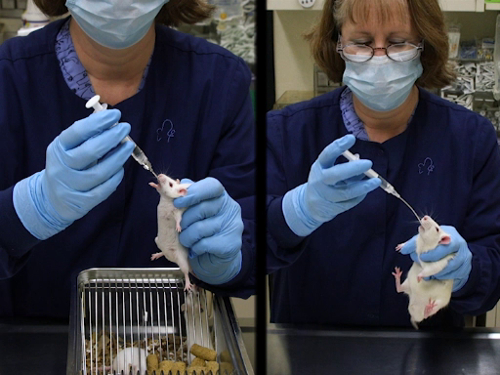화합물 투여 II
출처: 케이 스튜어트, RVT, RLATG, CMAR; 발레리 A. 슈뢰더, RVT, RLATG. 노틀담 대학교, IN
화합물 투여는 종종 동물 연구의 필수적인 구성 요소입니다. 화합물이 올바르게 전달되는지 확인하기 위해 많은 요인을 평가해야 합니다. 투여 경로는 흡수 메커니즘에 영향을 미칩니다. 도입되는 물질의 특성(pH, 점도 및 농도)은 어느 투여 경로가 선택되나 지시할 수 있습니다.1,2,3
1. 국소 응용 프로그램
- 연고와 크림을 바르기 전에, 탈모 크림을 사용하거나 면도하여 모든 털을 제거하십시오.
- 피부를 철저히 청소하고 건조시다.
- 면팁 어플리케이터또는 직접 배치된 드롭을 통해 피부에 직접 물질을 발라 기술자의 접촉을 피하십시오.
- 최상의 결과를 얻으려면 두꺼운 층을 한 번에 바르는 것에 반하는 연고 또는 크림의 여러 얇은 층을 적용하십시오.
- 모발을 이별하고 노출된 피부에 방울을 바르면 액체를 바르습니다.
- 물질을 국체적으로 적용할 때, 동물을 손질하기 때문에 전신 흡수의 가능성이 있다. 사고 섭취 또는 물질의 조기 제거를 피하기 위해 예방 조치를 취해야 합니다. 작은 칼라 나 방패는 동물이 영향을받는 신체 부위에 도달하지 못하도록 할 수 있습니다. 개별 하우징은 케이지 메이트의 알로그루밍을 방지하기 위해 필요할 수도 있습니다.
화합물 투여의 가장 안전하고 가장 인도적인 방법은 사료 또는 물에 통합할 수 있는 경우 구강 투여를 통해서이다. 구강 영역은 정확한 도징 방법이지만 동물에게 매우 스트레스가 되며 기술적 숙련도가 필요합니다. 국소 투여는 일반적으로 동물이 제대로 준비되면 거의 또는 전혀 억제없이 수행됩니다. 행정 경로를 신중하게 고려하려면 동물에 대한 잠재적 인 스트레스를 고려해야합니다.
- Turner, P.V., Pekow, C., Vasbinder, M. A., and Brabb, T. 2011. Administration of substances to laboratory animals: equipment and considerations, vehicle selection, and solution preparation. JAALAS. 50:5. 614-627.
- Shimizu, S. 2004. Routes of Administration in The Laboratory Mouse. Elsevier.
- Machholz, E., Mulder, G., Ruiz, C., Corning, B. F., Pritchett-Corning, K. R. 2012. Manual Restraint and Common Compound Administration Routes in Mice and Rats. J. Vis. Exp. (67), e2771, doi:10.3791/2771.
- Turner, P. V., Brabb, T., Pekow, C., Vasbinder, M. A. 2011. Administration of substances to laboratory animals: routes of administration and factors to consider. JAALAS. 50, 600-613.
- Hoggart, A.F., Hoggart, J., Honerlaw, M., and Pelus, L.M. 2010. A spoonful of sugar helps the medicine go down: a novel technique to improve oral gavage in mice. JAALAS. 49:3. 329-334.
- Gonzales, C., Zaleska, M.M., Riddell, D.R., Atchison, K.P., Robshaw, A., Zhou, H., and Rizzo, S.J. 2014. Alternative method of oral administration by peanut butter pellet formulation results in target engagement of BACE1 and attenuation of gavage-induced stress responses in mice. Pharmacology, Biochemistry, and Behavior. 126:28-35.
- Zumkehr, B., Hermann, C., Theurillat, R., Thormann, W., Gottstein, B., and Hemphill, A. 2012. Voluntary ingestion of antiparasitic drugs emulsified in honey represents an alternative to gavage in mice. JAALAS. 51:2. 219-223.
건너뛰기...
이 컬렉션의 비디오:

Now Playing
화합물 투여 II
Lab Animal Research
34.6K Views

설치류 취급 및 통제 기술
Lab Animal Research
173.0K Views

실험실 기본 관리
Lab Animal Research
27.6K Views

사육 및 이유의 기초
Lab Animal Research
35.5K Views

설치류 식별 I
Lab Animal Research
54.4K Views

설치류 식별 II
Lab Animal Research
25.4K Views

화합물 투여 I
Lab Animal Research
99.8K Views

화합물 투여 III
Lab Animal Research
31.2K Views

화합물 투여 IV
Lab Animal Research
51.2K Views

혈액 채취 I
Lab Animal Research
170.5K Views

혈액 채취 II
Lab Animal Research
72.6K Views

마취 유도 및 유지
Lab Animal Research
49.9K Views

설치류 수술에 대한 고려 사항
Lab Animal Research
22.3K Views

진단 부검 및 조직 수확
Lab Animal Research
57.7K Views

멸균 조직 수확
Lab Animal Research
34.6K Views
Copyright © 2025 MyJoVE Corporation. 판권 소유

